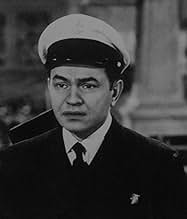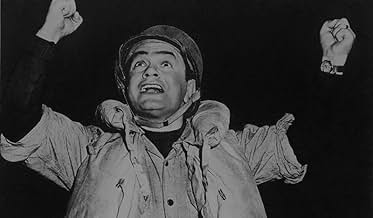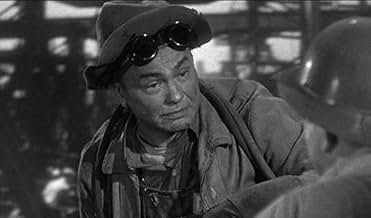IMDb-BEWERTUNG
6,3/10
1333
IHRE BEWERTUNG
Füge eine Handlung in deiner Sprache hinzuA new World War 2 destroyer fails its sea trials so it is assigned to mail runs, but the crew ends up having to engage Japanese planes and a submarine anyway.A new World War 2 destroyer fails its sea trials so it is assigned to mail runs, but the crew ends up having to engage Japanese planes and a submarine anyway.A new World War 2 destroyer fails its sea trials so it is assigned to mail runs, but the crew ends up having to engage Japanese planes and a submarine anyway.
Edward G. Robinson
- Steve Boleslavski
- (as Edward G.Robinson)
Edward Brophy
- Casey
- (as Ed Brophy)
Frank Beckford
- Yeoman
- (Nicht genannt)
Dean Benton
- Moore
- (Nicht genannt)
Lynton Brent
- Doctor
- (Nicht genannt)
Lloyd Bridges
- 2nd Fireman
- (Nicht genannt)
Charles D. Brown
- Doctor
- (Nicht genannt)
Stanley Brown
- Marine
- (Nicht genannt)
- …
George Bruggeman
- Cook
- (Nicht genannt)
Alma Carroll
- Sailor's Girl Friend
- (Nicht genannt)
Handlung
WUSSTEST DU SCHON:
- WissenswertesThe USS John Paul Jones in reality was the Benson Class destoyer USS Hobby (DD610). She was primarily used for Anti-Submarine Warfare (ASW) in both the Mediterranean and Pacific theaters. She servived the war, but would eventually be destroyed as a training target in 1972.
- PatzerWhen the Japanese torpedo strikes the John Paul Jones II, the ship's interior is shown to have its interior watertight doors open. Part of General Quarters (Battle Stations) procedure is to establish watertight integrity throughout a ship by shutting all watertight doors. This minimizes flooding in the event the ship is struck by enemy fire.
- Zitate
Girl at USO: I hear you got a raise.
Kansus Jackson: Yeah
Girl at USO: What are you going to spend it on?
Kansus Jackson: Oh, beer, women and the rest on foolishness.
- Crazy CreditsOpening credits prologue:
Destroyers --"Tin Cans" as they are affectionately called by those who man them -- are the busybodies of the Fleet.
Always looking for trouble -- generally finding it.
Proud little ships because they bear the names of great heroes of the Service and keep alive the fighting traditions of our Navy.
Ausgewählte Rezension
Others have commented about the fine cast, good acting and relative action in this film. What many viewers – and most or all of the commenters so far – may have missed is that the story and script for "Destroyer" came from Frank "Spig" Wead. Wead had an illustrious Navy career in WWI and later. He was one of the very first Navy fliers and helped promote naval aviation. In 1926, he broke his neck when he fell down the stairs in his family's new home. His surgery was successful, but he had to walk with crutches or a cane the rest of his life. He retired from the Navy and began writing books and screenplays. The latter were mostly about the Navy and most were made into very good movies.
When World War II broke out Wead was reactivated and helped with the planning and tactics involving naval aircraft in the Pacific. He went to sea and took part in several naval battles before finally retiring in early 1944. During the war and for several years after, he wrote the screenplays for a number of movies that Hollywood produced. Other big movies based on his books and screenplays include "Wings for Men" in 1931, "Test Pilot" in 1938, "The Citadel" in 1938, "Dive Bomber" in 1941, and "They Were Expendable" in 1945. Wead died at age 52 in 1947 after surgery. MGM produced a movie in 1957 about him, "The Wings of Eagles." John Wayne and Maureen O'Hara played Spig and his wife, Min.
Something about this movie, with the fact the Spig Wead wrote the story and screenplay, leads me to believe that there is a subtle message in it. The film came out toward the middle of the war, with two more years to go (although no one could know that at the time). And look at the plot. A new ship is taken out for trial runs and has so many things go wrong that it had to come back for repairs at least three times. We see rivets popping, seams leaking, pipes breaking, motors and other things blowing. As a viewer, I thought that the critics in the movie were right. The ship was a piece of junk – in spite of Edward G. Robinson's pleas to the contrary. And, just think – if that happened with all or many ships, it's a wonder we had a Navy afloat at all to do battle.
But that obviously wasn't the case – as the Navy brass ordered the ship to do mail delivery duty because it was unfit for service in the combat fleet. So, this ship just happened to be a lemon, right? Now think back to the opening scenes where Robinson is a civilian working on the crew that is building this new ship. Remember the several instances when he calls different workers to task for cutting corners? He tells one welder that he can't "cold" weld along a seam. The worker says that he can do that, and Robinson says that it would leak and he urges the guy to do it right. We see a few other subtle little scenes like this. I remember thinking that if that's the way the war-time shipbuilding yards were all working, they were sure doing a lot to help the enemy sink our ships.
But the volume of records and evidence we have show that our wartime industries and workers took pride in doing their jobs right and well. They knew that the planes, and ships, and tanks, and weapons they were making were for the Americans and other fighting men who were defending freedom and our shores with their lives. They were their sons and brothers, husbands and fathers, uncles and cousins, and boy friends and neighbors. So, the workers took pride in what they did and in doing it right.
That's why I think Wead wrote a subtle message into the screenplay – and Columbia kept it in the movie intentionally. It was a message to the home front workers about how important their jobs were and that they needed to do them well. The movie gave a picture of what could happen if the home front workers did sloppy work or cut corners. They would endanger the lives of many fellow Americans. They could cause the loss of ships, aircraft and battles.
If you doubt this, watch the movie again, and watch for those instances of shoddy or faulty workmanship that Robinson points out to his fellow workers. And then watch for the problems they have during their trial runs to get the ship battle ready. I'll just bet that the home front workers who saw this movie in 1943 were more than a little upset at what they saw. And if it had been up to them in real life, all those goldbrickers in the movie shipyard would have been canned.
When World War II broke out Wead was reactivated and helped with the planning and tactics involving naval aircraft in the Pacific. He went to sea and took part in several naval battles before finally retiring in early 1944. During the war and for several years after, he wrote the screenplays for a number of movies that Hollywood produced. Other big movies based on his books and screenplays include "Wings for Men" in 1931, "Test Pilot" in 1938, "The Citadel" in 1938, "Dive Bomber" in 1941, and "They Were Expendable" in 1945. Wead died at age 52 in 1947 after surgery. MGM produced a movie in 1957 about him, "The Wings of Eagles." John Wayne and Maureen O'Hara played Spig and his wife, Min.
Something about this movie, with the fact the Spig Wead wrote the story and screenplay, leads me to believe that there is a subtle message in it. The film came out toward the middle of the war, with two more years to go (although no one could know that at the time). And look at the plot. A new ship is taken out for trial runs and has so many things go wrong that it had to come back for repairs at least three times. We see rivets popping, seams leaking, pipes breaking, motors and other things blowing. As a viewer, I thought that the critics in the movie were right. The ship was a piece of junk – in spite of Edward G. Robinson's pleas to the contrary. And, just think – if that happened with all or many ships, it's a wonder we had a Navy afloat at all to do battle.
But that obviously wasn't the case – as the Navy brass ordered the ship to do mail delivery duty because it was unfit for service in the combat fleet. So, this ship just happened to be a lemon, right? Now think back to the opening scenes where Robinson is a civilian working on the crew that is building this new ship. Remember the several instances when he calls different workers to task for cutting corners? He tells one welder that he can't "cold" weld along a seam. The worker says that he can do that, and Robinson says that it would leak and he urges the guy to do it right. We see a few other subtle little scenes like this. I remember thinking that if that's the way the war-time shipbuilding yards were all working, they were sure doing a lot to help the enemy sink our ships.
But the volume of records and evidence we have show that our wartime industries and workers took pride in doing their jobs right and well. They knew that the planes, and ships, and tanks, and weapons they were making were for the Americans and other fighting men who were defending freedom and our shores with their lives. They were their sons and brothers, husbands and fathers, uncles and cousins, and boy friends and neighbors. So, the workers took pride in what they did and in doing it right.
That's why I think Wead wrote a subtle message into the screenplay – and Columbia kept it in the movie intentionally. It was a message to the home front workers about how important their jobs were and that they needed to do them well. The movie gave a picture of what could happen if the home front workers did sloppy work or cut corners. They would endanger the lives of many fellow Americans. They could cause the loss of ships, aircraft and battles.
If you doubt this, watch the movie again, and watch for those instances of shoddy or faulty workmanship that Robinson points out to his fellow workers. And then watch for the problems they have during their trial runs to get the ship battle ready. I'll just bet that the home front workers who saw this movie in 1943 were more than a little upset at what they saw. And if it had been up to them in real life, all those goldbrickers in the movie shipyard would have been canned.
Top-Auswahl
Melde dich zum Bewerten an und greife auf die Watchlist für personalisierte Empfehlungen zu.
- How long is Destroyer?Powered by Alexa
Details
- Erscheinungsdatum
- Herkunftsland
- Sprachen
- Auch bekannt als
- Destroyer Men
- Drehorte
- Produktionsfirma
- Weitere beteiligte Unternehmen bei IMDbPro anzeigen
- Laufzeit1 Stunde 39 Minuten
- Farbe
- Seitenverhältnis
- 1.37 : 1
Zu dieser Seite beitragen
Bearbeitung vorschlagen oder fehlenden Inhalt hinzufügen




































